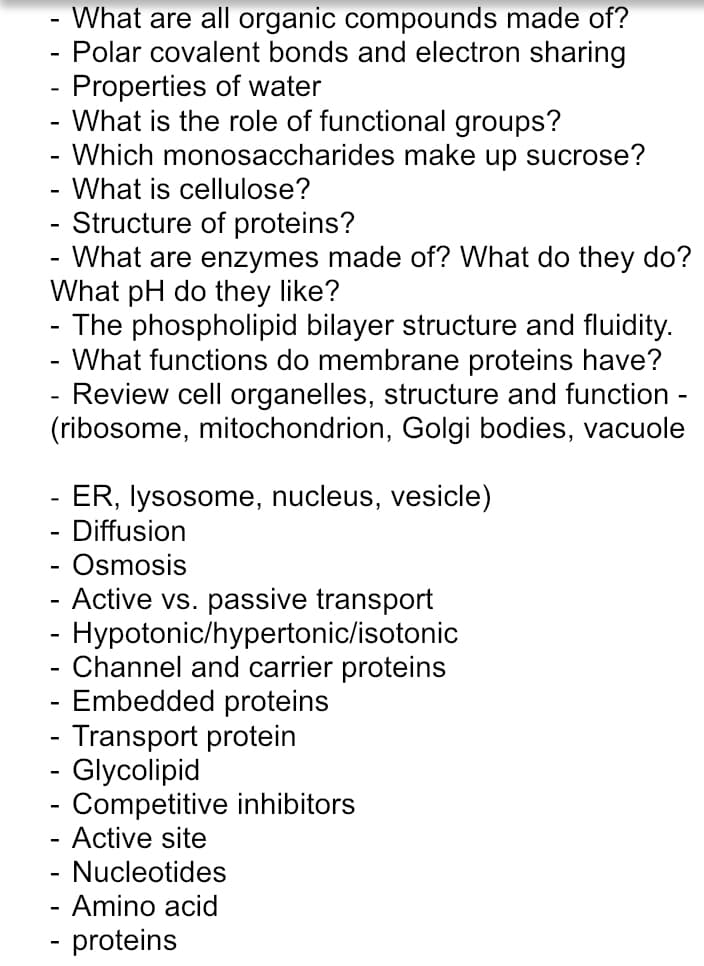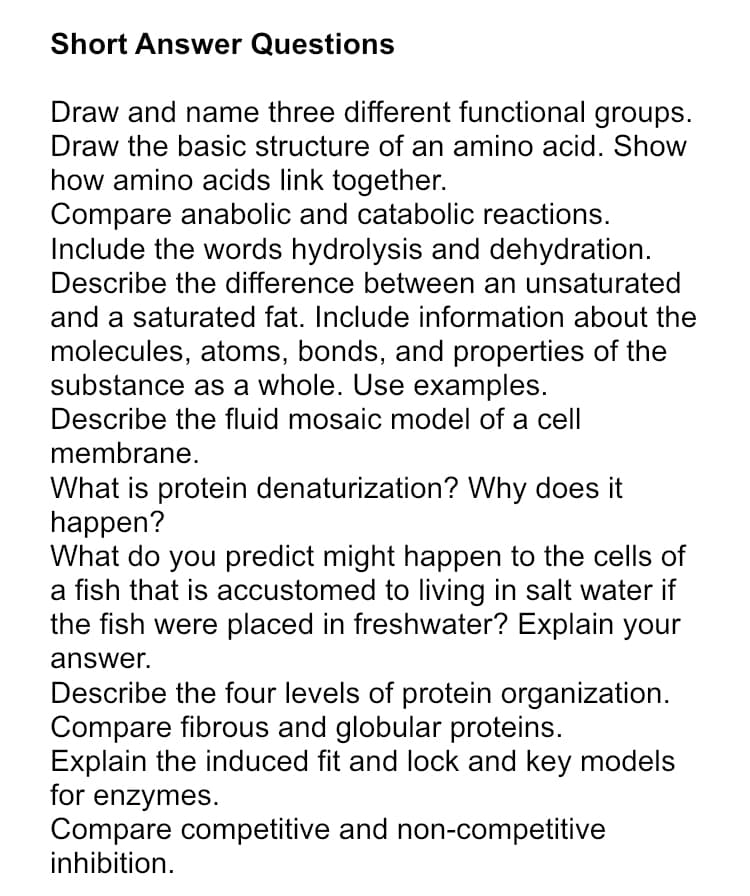What are all organic compounds made of?
Anatomy & Physiology
1st Edition
ISBN:9781938168130
Author:Kelly A. Young, James A. Wise, Peter DeSaix, Dean H. Kruse, Brandon Poe, Eddie Johnson, Jody E. Johnson, Oksana Korol, J. Gordon Betts, Mark Womble
Publisher:Kelly A. Young, James A. Wise, Peter DeSaix, Dean H. Kruse, Brandon Poe, Eddie Johnson, Jody E. Johnson, Oksana Korol, J. Gordon Betts, Mark Womble
Chapter2: The Chemical Level Of Organization
Section: Chapter Questions
Problem 29RQ: A phospholipid ________. has both polar and nonpolar regions is made up of a triglyceride bonded to...
Related questions
Question
Answer all the questions please.

Transcribed Image Text:- What are all organic compounds made of?
Polar covalent bonds and electron sharing
- Properties of water
What is the role of functional groups?
- Which monosaccharides make up sucrose?
-
-
- What is cellulose?
- Structure of proteins?
What are enzymes made of? What do they do?
What pH do they like?
The phospholipid bilayer structure and fluidity.
- What functions do membrane proteins have?
- Review cell organelles, structure and function -
(ribosome, mitochondrion, Golgi bodies, vacuole
-
- ER, lysosome, nucleus, vesicle)
Diffusion
-
Osmosis
- Active vs. passive transport
- Hypotonic/hypertonic/isotonic
- Channel and carrier proteins
- Embedded proteins
- Transport protein
- Glycolipid
- Competitive inhibitors
Active site
- Nucleotides
- Amino acid
- proteins

Transcribed Image Text:Short Answer Questions
Draw and name three different functional groups.
Draw the basic structure of an amino acid. Show
how amino acids link together.
Compare anabolic and catabolic reactions.
Include the words hydrolysis and dehydration.
Describe the difference between an unsaturated
and a saturated fat. Include information about the
molecules, atoms, bonds, and properties of the
substance as a whole. Use examples.
Describe the fluid mosaic model of a cell
membrane.
What is protein denaturization? Why does it
happen?
What do you predict might happen to the cells of
a fish that is accustomed to living in salt water if
the fish were placed in freshwater? Explain your
answer.
Describe the four levels of protein organization.
Compare fibrous and globular proteins.
Explain the induced fit and lock and key models
for enzymes.
Compare competitive and non-competitive
inhibition.
Expert Solution
This question has been solved!
Explore an expertly crafted, step-by-step solution for a thorough understanding of key concepts.
Step by step
Solved in 2 steps with 1 images

Recommended textbooks for you

Anatomy & Physiology
Biology
ISBN:
9781938168130
Author:
Kelly A. Young, James A. Wise, Peter DeSaix, Dean H. Kruse, Brandon Poe, Eddie Johnson, Jody E. Johnson, Oksana Korol, J. Gordon Betts, Mark Womble
Publisher:
OpenStax College

Biology: The Unity and Diversity of Life (MindTap…
Biology
ISBN:
9781305073951
Author:
Cecie Starr, Ralph Taggart, Christine Evers, Lisa Starr
Publisher:
Cengage Learning

Anatomy & Physiology
Biology
ISBN:
9781938168130
Author:
Kelly A. Young, James A. Wise, Peter DeSaix, Dean H. Kruse, Brandon Poe, Eddie Johnson, Jody E. Johnson, Oksana Korol, J. Gordon Betts, Mark Womble
Publisher:
OpenStax College

Biology: The Unity and Diversity of Life (MindTap…
Biology
ISBN:
9781305073951
Author:
Cecie Starr, Ralph Taggart, Christine Evers, Lisa Starr
Publisher:
Cengage Learning